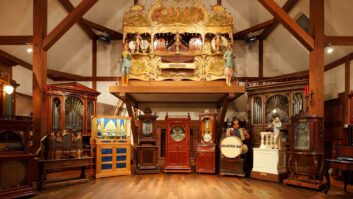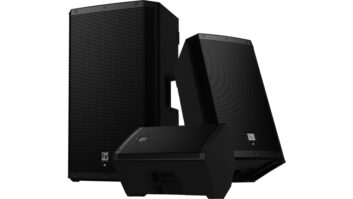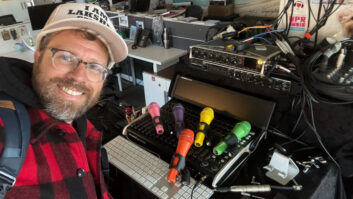The Lawson L251 is a side-address, dual-diaphragm tube condenser mic that offers many extras, including
an infinitely variable polar pattern, two bass-frequency contour settings
and a 10dB pad. The mic’s model number is derived from its
faithful reproduction of the 1-inch, 6-micron capsule used in the
venerable Telefunken Ela M 251 tube mic. Like Lawson’s other mics, the
L251 oozes artistic coloration and has a distinctly vintage vibe.
MAINTAINING FAMILY TIES
The L251 will look familiar to anyone who has worked with the company’s
L47MP. Both mics have a cylindrical shape and roughly the same
dimensions. There are two cosmetic finish options: Buyers can order the
L251 with either a nickel-plated or 24-karat-gold head grille and base
for the same price. All of Lawson’s head assemblies (capsule and
grille) are interchangeable, allowing you to easily mix and match
capsules with different mic bodies and electronics. The company also
offers head assemblies for sale a la carte.
Weighing a full two pounds and measuring 9¾ inches in length
and 2? inches in diameter, the L251 demands a sturdy mic stand with a
short, counterbalanced boom arm to keep it from sagging out of
position. The included mic stand adapter secures the L251 via an
integral O-shaped ring that slips over and tightens around the mic’s
connector housing. This is a bomb-proof design that allows the L251 to
securely hang upside down. As the L251’s capsule is internally
shock-mounted, an external shock-mount is not required.
The L251 connects to its remote power supply using the supplied
30-foot cable with latching 7-pin, gold-plated Neutrik connectors. The
cable is long enough in most situations to place the power supply in
the control room while tracking with the mic in the studio. That’s a
real advantage, because most of the controls for the
L251—including the infinitely variable polar pattern control,
10dB pad and bass frequency contour switch—are on the power
supply, and they change the response of the mic quite dramatically.
The rotary polar pattern control smoothly transitions through all
possible responses, from omni mode through cardioid to figure-8. The L251’s 10dB pad lowers
the capsule’s polarizing voltage, thus lowering the input level to the
vacuum tube. The bass frequency contour switch provides two alternate
settings: One, labeled “-BASS/L251,” introduces a
6dB/octave roll-off at 100 Hz to emulate the original Ela M 251’s bass
frequency response. (A fixed roll-off was engineered into the vintage mic to
counteract its gargantuan bass proximity effect.) The other setting, labeled
“+BASS/L47,” flattens the response to provide extended lows
and a more dramatic proximity effect. Lawson generally recommends that
users choose the +BASS/L47 setting when using the power supply with a
Lawson L47MP MKII mic, but there’s no reason why you can’t use this
setting with the L251, as well. I generally preferred using the
-BASS/L251 setting, because it lent more transparency to the mic’s
overall sound.
POLAR STROLLER
Turning the power supply’s polar pattern control knob yields different
frequency responses for the L251. The supplied specs and frequency
response charts are not exact enough to cite responses down to the
precise dB and kHz, but here’s the general scoop: All patterns produce
a broad 3 to 4dB peak at around 10 kHz and a response roughly 7 to 9 dB
down at 20 kHz, yielding a nice presence peak and a soft vintage-style
top end. As the polar pattern becomes increasingly more directional, a
smooth hump between 3 and 7 kHz develops, culminating in roughly a 5dB
boost in bidirectional mode in this band. Likewise, bass response below
200 Hz increases as the pattern becomes more directional.
A switch on the bottom of the L251 disables the power supply’s polar
pattern control and puts the mic into fixed-cardioid mode. (A
cool-looking blue LED lights up inside the windscreen when you’re in
multipattern mode—a nice reminder.) This
“cardioid-only” mode takes the mic’s rear diaphragm
completely out of circuit, resulting in 3dB lower self-noise and 3dB
hotter output. Sensitivity is specified to be 18 mv/Pa (at 1 kHz) in
cardioid-only mode vs. 11.6 mv/Pa in multipattern mode.
The L251 uses a dual-triode 6N1P (6922) tube—currently in
production and widely available—in a configuration that uses both
halves of the triode wired in parallel. This scheme lowers the noise
floor an additional 3 dB (resulting in a conservatively rated 13dBA
equivalent noise level in cardioid-only mode) and halves the tube’s
output impedance, reducing the possibility of current
limiting and therefore increasing headroom. Maximum SPL is rated to be
134dB SPL (for 3% THD at 1 kHz) with the pad switched out, and 144dB
SPL with it switched in. One other touch: The tube socket uses
gold-plated beryllium-copper contacts with secure grip and low contact
resistance to further thwart noise.
Lawson includes a foam-lined, water- and air-tight Pelican case to
store and transport the L251 and all accessories. It’s a tight fit to
get everything in the case, but there’s no denying that this is a great
extra.
TAKING THE L251 FOR A RIDE
My first test with the L251 was an A/B comparison with an original
Lawson L47MP (not the newer mkII version), with both mics recording
male vocals in cardioid (cardioid-only mode for the L251). To avoid
additional coloration, I used my ultratransparent, Millennia HV-3D
8-channel mic pre and Apogee Rosetta 96 A/D with the two mics. The L251
in -BASS/L251 mode reproduced much more depth than the L47MP, as well
as a fuller bottom end, more highly resolved midrange and more detailed
(yet still soft) highs. The L251 also exhibited markedly lower noise
and a tad higher output compared to the L47MP.
Recording another male vocalist with the L251 set to cardioid-only
and -BASS/L251 modes, I was struck by the mic’s warm, velvety character
and sweetly articulated highs. In order to achieve the pop sound I was
after, I needed to apply a highpass filter at 105 Hz and a fair amount of
high-shelving EQ boost to the track, but that’s typical treatment for a
pop mix with almost any mic. The end result sounded gorgeous, brimming
with sweet tube character. On female vocals, the L251 reproduced a
similarly full bottom, soft highs and velvety texture.
I once again chose the -BASS/L251 setting when using the L251 as a
room mic to record drums. I found the +BASS/L47 setting captured too
much kick drum and was too boomy in this application. In -BASS/L251
mode, however, the L251 is an outstanding room mic. The creamy texture
it lent to the sound was the perfect complement to the solid-state mics
placed close in on the kit.
Finally, when recording acoustic guitar, the L251 lacked the
high-end sparkle and detail I was after and had too round of a bottom
end for my taste.
CONCLUSIONS
At $2,495 (factory-direct), the L251 is fairly pricey, but no more so
than other mics of the same ilk. The mic’s plethora of controls produce
many useful timbres, while always maintaining a creamy texture. For
those who seek a new tube mic with vintage character, the L251 is a
very worthy candidate.
Lawson, www.lawsonmicrophones.com







